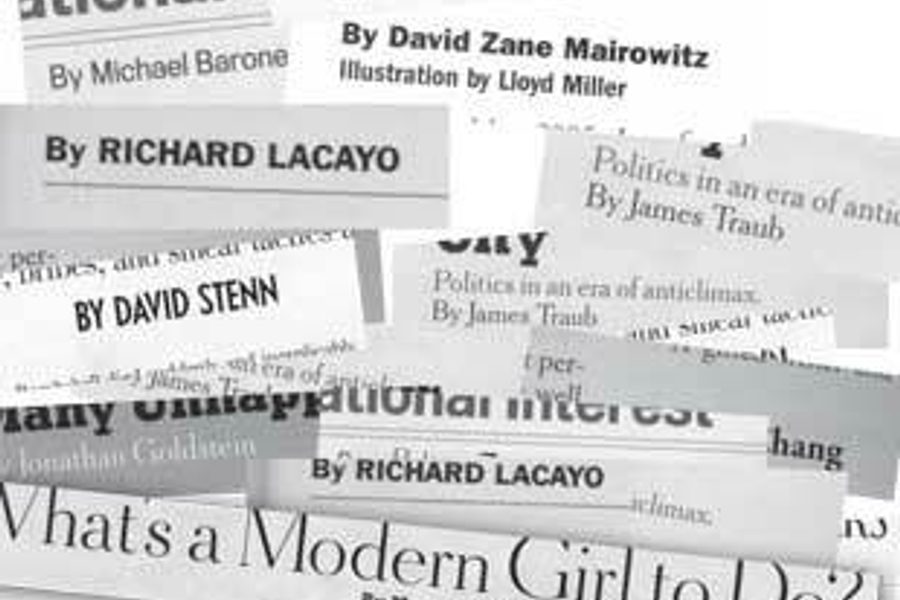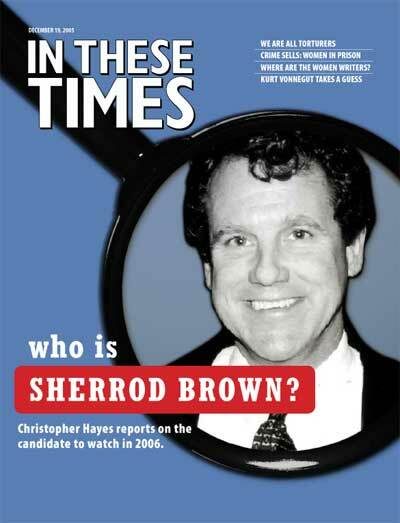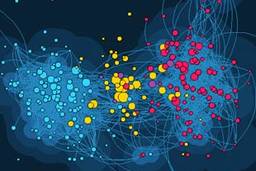
Sayonara, Judy Miller. Maureen Dowd is the latest “it girl.” Arianna Huffington made the rounds, touting the joys of bloggery, but Dowd pushed her aside with a potent mix of hair flipping and flip assertions.
Perhaps a recent study demonstrating that the female voice is more complex than the male voice explains why only one token smart woman can dominate the headlines at a given time – any more would boggle the mind! This might also account for the dearth of female commentators in the agenda-setting national media, an issue that has been bubbling since the spring.
The latest burble is a comparison of the ratio of male to female bylines in five national “general interest” magazines by Ruth Davis Konigsberg, a deputy editor of features at Glamour. As of mid-November, the tally among The Atlantic Monthly, Harper’s, the New York Times Magazine, The New Yorker and Vanity Fair was running 377 to 124.
“They’re all great magazines,” says Konigsberg, who is maintaining the count at www.womentk.com (a site unaffiliated with Glamour). “I just think that they can be even better with more women’s voices and perspectives.”
At In These Times? At last count: 27 percent.
Konigsberg’s project barely breaks the surface, however, compared to this spring’s “Opiniongate,” which pitted Los Angeles Times contributing editor, Susan Estrich against the editorial page editor Michael Kinsley. Estrich raised a stink after documenting that on average only 20 percent of the editorials were written by women.
The high-profile exchange sparked an acrimonious national debate about why female writers are underrepresented in “serious” media, including front-page stories, the news-driving Sunday talk shows and the blogosphere. Commentators (many of them female) advanced a range of theories to explain the gap, from the biological (women aren’t “hardwired” for debate) to the structural (the dudes are keeping us down).
A lack of up-and-coming female writers isn’t the issue. “I am doing my best to sensitize the 28 percent of my students who are male and are most to likely get 90 percent of the good jobs – some of whom probably didn’t do as well as the female students, who make up 72 percent of the student body,” says Michele Weldon, an assistant professor at Northwestern’s Medill School of Journalism.
Many rightly point out that female journalists have traditionally been shunted to soft news. Kara Jesella, who is writing a book on the upstart ’90s teen magazine, Sassy, says that fashion magazines provide young women with attractive career opportunities. “We can see our name in print, manage whole departments, travel. We are making more than $18,000 a year (the assistant salary at most magazines.)
“The problem arises when you want to do other kinds of writing and find that you’ve been typecast,” Jesella continues. Does the same go for men? “My former next-door neighbor spent a few years covering sports for The New York Times,” Jesella notes. “Since the war, he has been in Iraq and I see his byline regularly on the front page.”
So it goes – even at the most progressive of magazines. “The answer is more complex than mounting a letter-writing campaign,” says Sarah Blustain, the deputy editor at The American Prospect and former managing editor at The New Republic. “It’s not that editors aren’t aware of the problem. The newsroom culture is not scientific. It’s human, and these dynamics are hard to overcome. “
Still, they can be hard to bear. “At The New Republic, every Monday morning we would sit around and talk about that weekend’s basketball games,” says Blustain. “We would make little uncomfortable jokes about why I didn’t know what was going on. There was something alienating about that.”
And who defines “news”? “My experience is that an awful lot of straight male editors do not see anything related to the reproductive organs as a serious public policy issue,” says writer E.J. Graff, who most recently collaborated on Evelyn Murphy’s new book, Getting Even: Why Women Still Don’t Get Paid Like Men & What to Do About It. “Unfortunately, those magazines help set the public policy agenda for the country.”
Women are spearheading a crop of new projects to address these issues. Since 2002, POWER Sources, which matches journalists from independent and national media up with diverse female experts, has been a core project of the media advocacy organization Women In Media & News (WIMN). “They’re experts in everything from arms to zoology,” WIMN’s director Jennifer Pozner says. This philosophy inspired the organization’s newest project, a blog on women and media to be launched by the end of the year. So far, 50 women, including Laura Flanders and Medea Benjamin, have committed to blog on 50 topics.
Two other projects backed by prominent feminists have also emerged in recent months: SheSource touts women with clout as sources for the mainstream media, and the Women’s Media Center, backed by Jane Fonda and Gloria Steinem, highlights the work of female commentators.
For some, these efforts can’t come soon enough. “I have lately been fantasizing about grant funding to start a ‘farm-team’ project that recruits young women and cultivates women political writers,” says Alexandra Walker, executive editor of the progressive Web site TomPaine.
Make way, Maureen.







